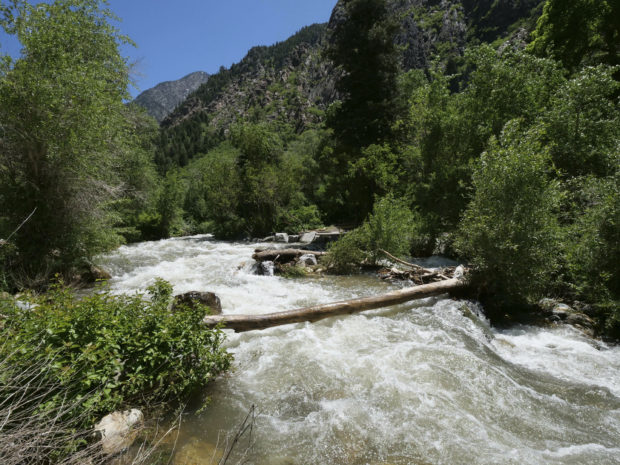Parched US Southwest gets reprieve as snowmelt fills rivers
DENVER – A welcome surge of melting snow is pouring out of the Rocky Mountains and into the drought-stricken rivers of the southwestern U.S., fending off a water shortage but threatening to push rivers over their banks.
Last winter brought above-average snowfall to much of Colorado, Utah and Wyoming, so an abundance of snowmelt is rushing into the Colorado River, the Rio Grande and other waterways after a desperately dry 2018.

This Monday, June 10, 2019, photo shows the Big Cottonwood Creek, in the Big Cottonwood canyon, near Salt Lake City. The summer’s melting snowpack is creating raging rivers that are running high, fast and icy cold. The state’s snowpack this winter was about 150 percent higher than the historical average and double the previous year, which was the driest on record dating back to 1874, said Brian McInerney, hydrologist for the National Weather Service in Salt Lake City. Large parts of the Salt Lake City metro area sits near the foothills of the towering Wasatch Range. (AP Photo/Rick Bowmer)
“It couldn’t have come at a better time,” said Greg Smith, a hydrologist with Colorado Basin River Forecast Center, part of the National Oceanic and Atmospheric Administration.
“There’s this big sense of relief this year that we’ve kind of rebounded.”
Colorado was blanketed by 134% of its normal snowfall last winter.
Utah was even better, at 138%. Southwestern Wyoming received its average amount.
Article continues after this advertisementThat will put so much water into the Colorado River that Lake Powell, a giant reservoir downstream in Utah and Arizona, is expected to rise 50 feet (15 meters) this year, said Marlon Duke, a spokesman for the U.S. Bureau of Reclamation, which manages Powell and dozens of other reservoirs.
Article continues after this advertisementThe reservoir is rising so fast — 6 to 15 inches (15 to 38 centimeters) a day — that the National Park Service warned people to keep cars and boats at least 200 yards (183 meters) from the shoreline to keep them from being submerged overnight.
The influx into Powell will allow the Bureau of Reclamation to send enough water downstream into Lake Mead in Arizona and Nevada to avoid a possible water shortage there. Arizona, California and Nevada rely heavily on the reservoir.
Last year, the bureau predicted a better than 50% chance that Mead would fall so low that Arizona — which has the lowest-priority rights to the reservoir — would have to take a cut in its share in 2020. The shortage now might be put off until after 2021, Duke said.
The Colorado River is expected to send more than 12 million acre-feet into Powell this year, 112% of average and a huge improvement over last year, when scant snow in the Rocky Mountains produced only 4.6 million acre-feet for the reservoir.
An acre-foot, or 1,200 cubic meters, is enough to supply a typical U.S. family for a year.
The bureau expects to release 9 million acre-feet from Powell to Mead for the fifth consecutive year.
The news is also good for the Rio Grande, which flows from Colorado through New Mexico and then along the Texas-Mexico border to the Gulf of Mexico.
Elephant Butte, a massive reservoir on the Rio Grande in New Mexico, had dropped as low as 10% of capacity, but it could reach 30% this year, said Carolyn Donnelly, a water operations supervisor for the Bureau of Reclamation.
“Given last year, which was really one of the lowest years on record, it’s been a complete turnaround,” she said.
Besides replenishing reservoirs — a boon to cities and farms that depend on them — the surging rivers mean good rafting conditions, but some sections are so wild that guides are avoiding them.
Last week, a rafting accident killed a 29-year-old man on Colorado’s Eagle River, and a 5-year-old boy had to be rescued from a river in a Salt Lake City suburb.
A popular hike along a riverbed in Utah’s Zion National Park has been closed since April 1 because of high water.
It could be two weeks before water levels fall enough to make the trail safe, park spokeswoman Aly Baltrus said.
Colorado authorities spent weeks clearing debris that threatened to clog streams around the small town of Lake City in the southwestern part of the state.
Winter avalanches left behind dead trees and rubble that could have backed up the streams and then given way, sending a wall of water into the town, said Micki Trost of the state’s emergency management division. /gsg